2012 Nissan Juke SV AWD vs. 2011 Mini Cooper S Countryman ALL4, 2012 Jeep Compass Latitude 4x4
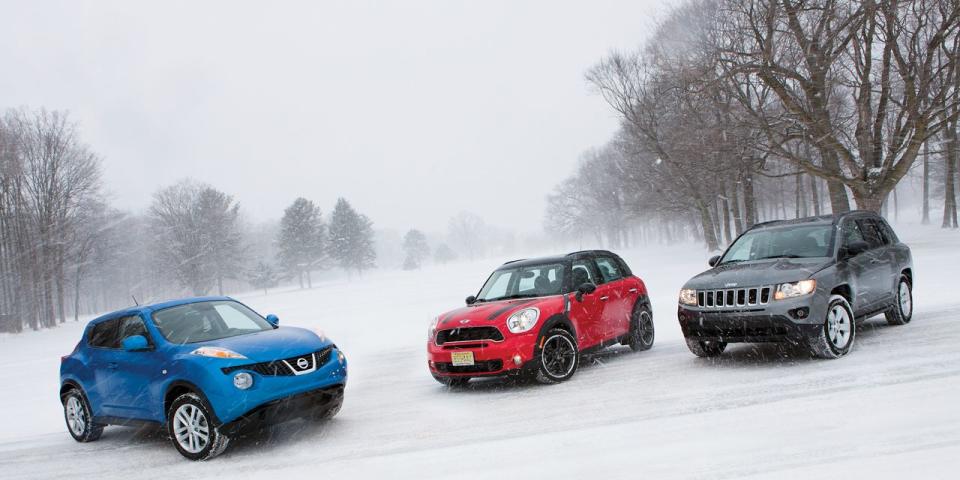


In June 1968, Richard Robison, his wife, and their four children were gathered around the living-room table, playing cards in their summer cottage, two miles north of Good Hart, Michigan. That's when a killer wielding a rifle opened fire through a window. He then entered the cabin and, brandishing a handgun, concluded his grisly business, shooting all six family members and bludgeoning the daughter with a claw hammer.
Twenty-seven days passed before police discovered the bodies, along with bloody footprints, shell casings, and the hammer. But to this day—more than 43 years later—the crime remains unsolved.
Long since razed, the Robisons' cottage stood just off Route 119, the so-called Tunnel of Trees road. For more than 20 miles, this almost continuously damp byway twists and coils and randomly opens to towering views of Lake Michigan, 100 feet below. Fog rolls in, and dense stands of birch and pine lean at grotesque angles above the roadway, creating a perpetual crepuscular gloaming. It's nirvana as long as you're E.A. Poe.
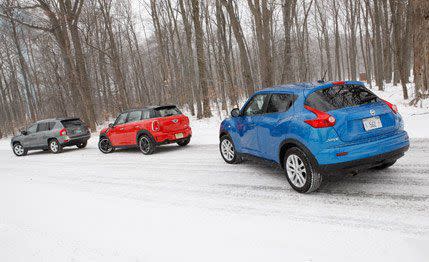
Our goal was to assemble the universe of miniature utes sporting all-wheel drive, then wring them out on Route 119, damn the swirling mists, the snow, and the sinister twilight. From the get-go, our candidates were few. That's because neither the Kia Soul nor the Nissan Cube is offered with all-wheel drive. Honda's Element has been returned to the elements. And the Mitsubishi Outlander Sport offers neither the character nor the sport (0 to 60 mph in 9.9 seconds) to entice. And so we were three.
The recipe for success in this curious niche is still somewhat obscure. But sure-footedness in foul weather is certainly part of the formula, as is a useful amount of cargo-carrying capacity. A successful mini-ute must also drive like a car—SUVishness is a vice. Moreover, some sort of recognizable personality should emerge.
You should know that when our trio halted in Good Hart—less a village than a general store at a crossroads—one of us deposited the Nissan Juke's keys on its roof to ensure they'd not be locked within. Alas, the Juke can be started if its fob is merely in the neighborhood—such as on the roof. That's how it accidentally got flung unseen atop the roadway when our travels resumed.
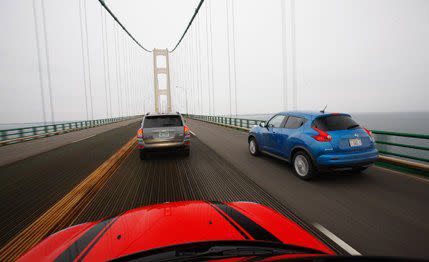
For 30 minutes, four of us searched for the black fob. When we found it—amidst a clump of snowy leaves on the berm—we realized it had inexplicably clung to the Juke's convex roof for 1.9 miles, then had fallen weirdly onto land that would have overlooked the Robisons' cottage of doom.
That was in mid-January on a day so dark that headlights were mandatory from dawn to dusk. Exactly no one was in the woods with us. The temp hovered in the 20s, no animals were perambulating—seemingly not even birds—and it was mere hours before an atmosphere-sucking blizzard put the utes' AWD systems to a critical test.
It gave all of us a chill. A big chill.
During the darkest of Chrysler's recent, uh, financial adventures, the company's engineers busied themselves with cost-effective fixes. The Jeep Compass, for example, along with its similarly unloved cousin, the Dodge Caliber, benefited from styling upgrades inside and out, from CVT recalibrations, and from a warehouse full of NVH remedies.
In fact, what you notice first about the Compass is how much more soothing it is on freeway slogs, where, in fact, it became the ute each staffer most wanted to inhabit. At 70 mph, the Jeep was by far the quietest in our group. It also offered the best ergonomics—simple, straightforward, logically located and labeled switchgear, with huge rotary HVAC controls that could be operated when we were wearing gloves.
The Compass was also something of a bus—wider, longer, and taller than its colleagues, with the highest center of gravity. In the hills, unfortunately, it rolled and pitched and was ever reluctant to hustle. Its mushy brakes, 189-foot stopping distance from 70 mph, and sloppy steering further banished it to the dunce stool. And even though the Compass offers the largest engine in this group, it produces the least power and torque. To 60 mph, this Jeep was more than two seconds behind its mates, with its pilot constantly shouting on the radio, "Guys, show some mercy, eh?"
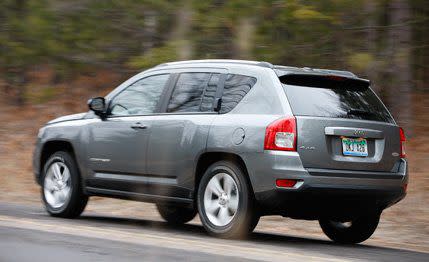
Still, there were a few high notes. The Jeep's cushy ride was hugely appreciated over Michigan's monster frost heaves. The Compass runs on regular fuel. It offers a selectable 4wd-lock mode and became our clear favorite when the blizzard descended. It won our back-seat contest easily. And it is the only vehicle in this group rated to tow anything—in this case, 1000 pounds.
The Compass's generous interior dimensions also make it a practical purchase: It offers the largest, flattest cargo floor, with rear cargo space surpassing, say, the Juke's by a colossal 12 cubic feet.
Chrysler's upgrades are swell, but the Compass remains slow to react to all primary inputs. It is bland in all of its moves, the least likely to offend and the least likely to satisfy—like the house wine at a Chinese restaurant. Here's what our compass says: Wait for the all-new version due in 2013, riding on an Alfa Giulietta platform with a ZF-designed nine-speed transmission.
It certainly wasn't our idea to test a Mini Cooper Countryman with an as-tested price $11,185 beyond, say, the Juke's. But that's how our specimen showed up, chockablock with convenience packages, Harman/Kardon stereo, a sunroof, and 18-inch wheels with summer rubber—the latter doing damage to the Mini's ride, adding to its dartiness, and scaring the Cheez Whiz out of us when the blizzard arrived. Speaking of grip, the Mini's marketers should get one: $250 for a center armrest? Another $250 for a cargo net? Puh-leeze.
The Countryman was certainly the sports car in this group, with quick, accurate steering that weighted up more satisfyingly than the Juke's. It was the fleetest through our slalom and equaled the Nissan in quarter-mile acceleration. Brake feel was superb, and the 156-foot stopping ability beats that of the last Porsche 911 Turbo S we tested. What's more, its transmission—the only non-CVT in the group, thus by default our favorite—was shiftable via paddles or lever.
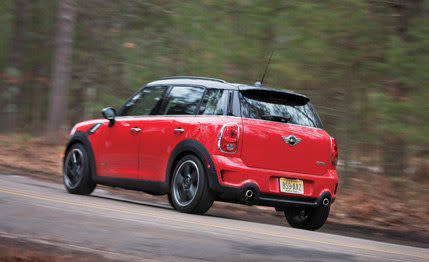
As we implied, though, we'd be happy to lose the optional Goodyear run-flats. On our handling loop, the Mini was a nervous little countryman, shuffling and bobbing over scabrous pavement. "It forces little exhalations from your lungs as if it's ramming the seat bottom up into your diaphragm," noted Pund. Notice that the Juke pulled an identical 0.85 g on the skidpad, even though its Goodyears were M+S–rated.
This swollen Mini—all Minis, in fact—would have more securely won our hearts if someone would sort out its cockpit goofiness. What seems fun at first—a speedometer the size of a basketball, window-lift toggles hidden in front of the shifter, the world's most mismatched and insanely located switchgear—isn't even remotely amusing during a white-knuckle midnight drive through sleet. We also noted that, with two largish males up front, this car always felt claustrophobic, full of hot air and bad breath. Also keep in mind that the rear seats in our test car comprise two buckets only, although they're quite comfortable.
When the planets align—meaning perfectly smooth roads, sunshine, one man aboard, the sport button already located and selected by someone who knew how to find it—the Countryman proved the most fun to drive in our group, scoring points as fast as six-foot-seven, 260-pound Metta World Peace. Who, by the way, likely won't fit inside one.
The Rogue, the Cube, the Juke—Nissan is all huggermugger with adorable mini-utes, but if ever a weirdness competition breaks out between the three, the Juke will sail to victory. Its parking-lamp lenses are always in the driver's line of sight, resembling bulging carp eyeballs or, as deputy editor Daniel Pund so ungraciously put it, "gigantic toenail clippings." The idea for the center console came from a motorcycle gas tank. There's a whimsical "eyelid" hanging over the speedo and tach. And the owner's manual is secured by what very closely resembles thong underwear. "Not sure I'm gonna touch that," said Pund.
The Juke is the lightest vehicle in our group, and that defined its personality—a kind of airy, willing agility. Its steering is light, fluid, and informative. The electronically controlled AWD assists cornering by astutely rationing the torque delivered to each rear wheel. In heavy traffic, the Juke skillfully juked, making the most of its rapid-response turbo and offering up sightlines less obstructed than the Mini's. And on twisty roads, the Juke's logbook filled with other compliments: "Light and chuckable." "Good path control." "Sure-footed." "The best ride/handling trade-off." What's more, the CVT knocked off supercrisp "downshifts," supplying all the revs necessary to slingshot out of turns, again aided by the torque-vectoring AWD. Plus, we all praised the Juke's firm, nicely bolstered seats, upholstered in grippy fabric.
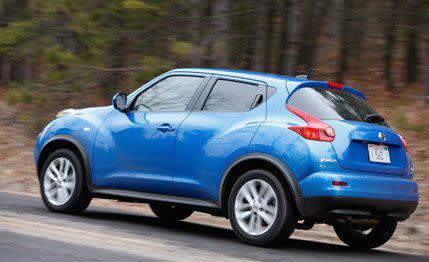
Strangely, the handling kudos come with a warning. When hustled near its limits, the AWD Juke begins to float and skip, dancing over road irregularities. At which point, whatever the tires are doing becomes a state secret.
The biggest knock against the Juke is that it offers the least cargo-carrying capacity. It swallowed the fewest cases of beer and the shortest length of pipe. And with three adults in back, expect to hear cries of desperation and outrage.
"The more I drive the Juke, the more it charms me," offered associate online editor Jon Yanca. "But they should've named it the Frogstar."
You Might Also Like

 Yahoo Autos
Yahoo Autos 